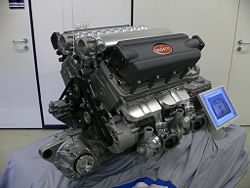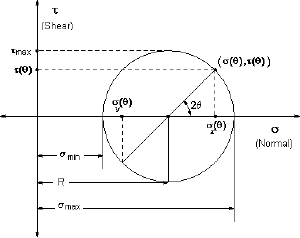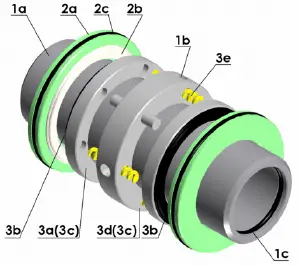Mechanical engineering

Mechanical Engineering is the engineering discipline that involves application of the principles of physics for the analysis, design, manufacture, and maintenance of mechanical systems. It requires a solid understanding of concepts including mechanics, thermodynamics, and engineering design; as well as solid grounding in physics and math. Mechanical engineers use these principles and others in the design and analysis of automobiles, heating and cooling systems, industrial equipment, and more.
History
The beginnings of mechanical engineering go back to the craftsmen and inventors of the first tools and basic machineries powered by human or animal labor, water or wind energy, or their combination. Mechanical engineering as a field of engineering study, however, did not start until the advent of the Industrial Revolution with the demand for the steam engine. The first professional society for mechanical engineers, the Institute of Mechanical Engineers, was formed in the United Kingdom in 1847. Since then, advancements in the field of mechanical engineering have lead to such breakthroughs as the internal combustion engine, which made heavier-than-air powered flight possible and would also lead to the development of the automobile, air conditioning, robotics, and more.
Process of mechanical engineering
The process of engineering design is, as described by Pahl and Beitz, "the intellectual attempt to meet certain demands in the best way possible…. an engineering activity that impinges on nearly every sphere of human life, relies on the discoveries and laws of science, and creates the conditions for applying these laws to the manufacture of useful products" (Pahl and Beitz, 1988).
There are generally four main phases to engineering design:
- Clarification of Task
- Conceptual Design
- Embodiment Design
- Detail Design
Basic aspects of design include:
- Design Concept
- Systems Engineering (function, safety, reliability, maintainability)
- Design of Elements (size, shape, material, life)
- Manufacturability (ease/difficulty with which a part can be made)
- Cost (planning, materials, construction)
Tools and work
Modern analysis and design processes in mechanical engineering are aided by various computational tools including finite element analysis (FEA), computational fluid dynamics (CFD), computer-aided design (CAD)/computer-aided manufacturing (CAM) and Failure Modes & Effect Analysis (FMEA). These modern processes facilitate engineers to model (create a 3D object in a computer), analyze the quality of design, and so on, before a prototype is created. By this the invention and experimenting with new designs becomes very easy and can be done without any money invested in tooling and prototypes. Simple models can be free and instantaneous, but complicated models, like those describing the mechanics of living tissue, can require years to develop, and the actual computation can be very processor intensive, requiring powerful computers and a lot of cycle time.
Mechanical engineering topics
The field of mechanical engineering can be thought of as a collection of many mechanical engineering subdisciplines. Several of these typically taught at the undergraduate level are listed below, with a brief explanation and common applications of each. Most work that a mechanical engineer does uses skills and techniques from several of these subdisciplines, as well as cross-over work with other engineering disciplines.
Mechanics
Mechanics is the physical science that deals with the state of rest or motion of bodies under forces (Meriam, 1966). It is the oldest of the physical sciences, and its early history is synonymous with the beginnings of engineering itself (Meriam, 1966). Subdisciplines of mechanics include:
- Statics, the study of the equilibrium of bodies under the actions of forces (Meriam, 1966).
- Kinetics, also known as Dynamics, the study of the actions of forces on bodies to their resulting motions (Meriam, 1966).
- Kinematics, the study of the motion of bodies without reference to the forces involved (Meriam, 1966).
- Mechanics of materials, also known as strength of materials or mechanics of deformable bodies; the branch of applied mechanics that deals with the behavior of solid bodies subjected to various types of loading (Gere, 2001).
- Continuum mechanics is a method of applying mechanics that assumes that objects are continuous. It is contrasted by discrete mechanics.
- Fluid Mechanics, the study of how liquids and gases (fluids) react to forces, and is based on the same principles as the mechanics of solids. Fluid mechanics is a subdiscipline of continuum mechanics, and can be further split into fluid statics and fluid dynamics. The application of fluid mechanics in engineering is called hydraulics (Daugherty, Franzini, and Finnemore, 1985).
Mechanics is used extensively in the design and analysis phases of a project. In vehicle design, statics will be employed in the design of the frame of the vehicle, in order to evaluate where and how the stresses will interact. Dynamics might be used when designing the car's engine, to evaluate the forces on the pistons and cams as the engine cycles. Mechanics of materials will be used to choose appropriate materials for each component of the frame and engine. Fluid mechanics will be used to design a ventilation system for the vehicle (see HVAC), and intake system of the engine.
Structural analysis
Structural analysis is the branch of engineering devoted to examining why and how parts fail. Structural failures occur in two general modes: Static failure and fatigue failure. Static structural failure occurs when, upon being loaded (having a force applied) the object being analyzed either breaks or is deformed plastically, depending on the criterion for failure. Fatigue failure occurs when an object fails after a number of repeated loading and unloading cycles. Fatigue failure occurs because of imperfections in the object.
Failure is defined as when a part does not operate as intended. Some systems, such as the perforated top sections of some plastic bags, are designed to break. If these systems do not break, failure analysis might be employed to determine the cause.
Structural analysis is often used by mechanical engineers after a failure has occurred, or when designing to prevent failure. Engineers may use various books and handbooks such as those published by ASM to aid them in determining the type of failure and possible causes.
Structural analysis may be used the office when designing parts, in the field to analyze failed parts, or in laboratories where parts might undergo controlled failure tests.
Thermodynamics
Thermodynamics is the study of energy, and its relationship with properties of matter (Moran and Shapiro, 1996). It is both a branch of physics and an engineering science (Moran and Shapiro, 1996). Engineers, being generally interested in systems and how they interact with their surroundings, extend thermodynamics to the study of systems through which matter flows (Moran and Shapiro, 1996).
Thermodynamic principles are used by mechanical engineers in the fields of heat transfer, thermofluids, and energy conversion and are considered in the design of engines and power plants, heating, ventilation, and air-conditioning (HVAC) systems, heat exchangers, heat sinks, refrigeration, insulation, life support systems, and other applications that require the movement of energy, work, matter, or the conversion of one into any of the others (Moran and Shapiro, 1996).
Drafting
Drafting or technical drawing is used in nearly every other branch of engineering and architecture. It is the means by which mechanical engineers create instructions for manufacturing parts. A technical drawing can be a computer model or hand-drawn schematic showing all the dimensions necessary to manufacture a part, as well as assembly notes, a list of required materials, and other pertinent information. A U.S. mechanical engineer or skilled worker who creates technical drawings may be referred to as a drafter or draftsman. Drafting has historically been a two-dimensional process, but recent Computer-Aided Designing (CAD) programs have begun to allow the designer to create a part in three dimensions.
Instructions for manufacturing a part must be fed to the necessary machinery, either manually, through programmed instructions, or through the use of a Computer-Aided Manufacturing (CAM) or combined CAD/CAM program. Optionally, an engineer may also have a part manually manufactured using the technical drawings, but this is becoming an increasing rarity, except in the areas of applied spray coatings, finishes, and other processes that cannot economically be done by a machine. Three-dimensional models created using CAD software are also commonly used in Finite element analysis (FEA) and Computational fluid dynamics (CFD).
List of cross-disciplinary topics
The following is a list of some cross-disciplinary topics within mechanical engineering. These topics require expertise in other fields of engineering in addition to a mechanical background.
- Automotive engineering
- Biomedical engineering
- Engineering-based programming
- Heating, ventilation, and air conditioning (HVAC)
- Mechatronics
- Power generation
Education
A Bachelor of Science (BS) / Bachelor of Arts (BA) degree in Mechanical Engineering is offered at many universities in most industrialized nations. In the U.S., Japan, Germany, Canada, Taiwan, South Korea, South Africa, and many other countries, Mechanical Engineering programs typically take four to five years, and result in a Bachelor of Science in Mechanical Engineering or BSc (Mech. Eng.). In some countries like Singapore, Malaysia, India, and Nigeria, a four-year Bachelor of Science (BSc) / Bachelor of Engineering (BEng) degree with Honors (Hons) in Mechanical Engineering is offered. In Australia and New Zealand, requirements are typically for a four-year Bachelor of Engineering (BE or BEng) degree, equivalent to the British MEng level. A BEng degree differ from a BSc degree in that the students obtain a broader education consisting of information relevant to various engineering disciplines.
Most Mechanical Engineering programs in the U.S. are accredited by the Accreditation Board for Engineering and Technology (ABET) to ensure similar course requirements and standards between universities. The ABET web site lists 276 accredited Mechanical Engineering programs as of June 19, 2006.[1] Mechanical Engineering programs in Canada are accredited by the Canadian Engineering Accreditation Board (CEAB).[2]
Some Mechanical Engineers go on to pursue a postgraduate degree such as a Master of Engineering, Master of Science, Master of Engineering Management (MEng.Mgt, MEM), a Doctor of Philosophy in Engineering (DEng, PhD) or an Engineer's degree. The Master's and Engineer's degrees may consist of either research, coursework or a mixture of the two. The Doctorate of Philosophy consists of a significant research component and is often viewed as the entry point to academia.[3]
Mechanical engineering programs generally cover the same fundamental subjects. Universities offering accredited programs in mechanical engineering are required to offer several major subjects of study, as determined by the parent nation's accreditation board. This is to ensure a minimum level of competence among graduating engineers and to inspire confidence in the engineering profession as a whole. The specific courses required to graduate, however, may differ from program to program. Universities will often combine multiple subjects into a single class or split a subject into multiple classes, depending on the faculty available and the University's major area(s) of research. Fundamental subjects of mechanical engineering include:
- Mechanics, which includes specific topics such as statics & dynamics, strength of materials, solid mechanics, fluid mechanics/fluid dynamics, hydraulics and pneumatics, and mechanism design (which includes kinematics)
- thermodynamics, which eventually covers topics such as heat transfer, energy conversion, and refrigeration / air conditioning,
- engineering drafting and design, which covers philosophy and methodology of design, CAD (usually including Solid modeling), manufacturing technology and processes, instrumentation and measurement, and CAM.[4]Harvard University, [5]
Mechanical engineers are also expected to understand and be able to apply basic concepts from chemistry, chemical engineering, electrical engineering, and physics. Mechanical engineering programs include several semesters of calculus, as well as advanced mathematical concepts including differential equations and partial differential equations, linear and modern algebra, and differential geometry, among others.
In addition to the core mechanical engineering curriculum, most mechanical engineering programs offer more specialized programs and classes such as mechatronics / robotics, transport and logistics, cryogenics, fuel technology, automotive engineering, biomechanics, vibration, optics, and others, if a separate department does not exist for these subjects.
Most mechanical engineering programs also require various research or design projects to gain practical problem-solving experience. Mechanical engineering students usually hold one or more internships while studying, though this is not typically mandated by the university.
Licensing
After earning their degrees, engineers may seek license with a state or national government. The purpose of this process is to ensure that engineers possess the necessary technical knowledge and real-world experience to engineer safely. Once certified, the engineer is given the title of Professional Engineer (in the United States, Canada, Japan, South Korea, and South Africa), Chartered Engineer (in the UK, Ireland, India and Zimbabwe), Chartered Professional Engineer (in Australia and New Zealand), or European Engineer (much of the European Union). Not all mechanical engineers choose to become licensed; those that do can be distinguished as Chartered/Professional Engineers by the post-nominal title PE or CEng, as in: Ryan Jones, PE.
In the U.S., to become a licensed Professional Engineer, an Engineer must pass the comprehensive FE (Fundamentals of Engineering) exam, work a given number of years (varies state by state) as an Engineering Intern (EI) or Engineer-in-Training (EIT), pass the Principles and Practice or PE (Practicing Engineer or Professional Engineer) exam. These requirements and steps of this process are set forth by the National Council of Examiners for Engineering and Surveying (NCEES), a national non-profit organization representing all states.
In the UK, current graduates require a MSc, MEng or BEng (Hons) in order to become chartered through the Institution of Mechanical Engineers. In most modern countries, certain engineering tasks, such as the design of bridges, electric power plants, and chemical plants, must be approved by a Professional Engineer or a Chartered Engineer. In the USA and Canada, only a licensed engineer may seal engineering work for public and private clients."[6] This requirement is written into state and provincial legislation, such as Quebec's Engineer Act.[7] In other countries, such as Australia, no such legislation exists; however, practically all certifying bodies maintain a code of ethics independent of legislation that they expect all members to abide by or risk expulsion.[8]
Workforce and educational statistics
The total number of engineers employed in the U.S. in 2004 was roughly 1.4 million. Of these, 226,000 were mechanical engineers (15.6 percent), second only in size to civil engineers at 237,000 (16.4 percent). The total number of mechanical engineering jobs in 2004 was projected to grow 9 to 17 percent, with average starting salaries being $50,236 with a bachelor's degree, $59,880 with a master's degree, and $68,299 with a doctorate degree. This places mechanical engineering at 8th of 14 among engineering bachelors degrees, 4th of 11 among masters degrees, and 6th of 7 among doctorate degrees in average annual salary.[9] The median annual earning of mechanical engineers in the U.S. workforce is roughly $63,000. This number is highest when working for the government ($72,500), and lowest when doing general purpose machinery manufacturing in the private sector ($55,850).
Canadian engineers make an average of $28.10 per hour with 3 percent unemployed. The average for all occupations is $16.91 per hour with 5 percent unemployed. Eight percent of these engineers are self-employed, and since 1994 the proportion of female engineers has remained constant at 4 percent.[10]
See also
Notes
- ‚ÜĎ ABET, Searchable database of accredited engineering programs. Retrieved June 19, 2006.
- ‚ÜĎ CEAB, Accredited engineering programs in Canada. Retrieved April 18, 2007.
- ‚ÜĎ MIT, Types of post-graduate degrees offered at MIT. Retrieved June 19, 2006.
- ‚ÜĎ University of Tulsa, Required ME Courses. Retrieved June 19, 2006.
- ‚ÜĎ Harvard Mechanical Engineering Page. Retrieved June 19, 2006.
- ‚ÜĎ NSPE, Why Should You Get Licensed? Retrieved July 11, 2005.
- ‚ÜĎ Quebec Statutes and Regulations (CanLII), Engineers Act. Retrieved July 24, 2005.
- ‚ÜĎ Online Ethics Center, Codes of Ethics and Conduct. Retrieved July 24, 2005.
- ‚ÜĎ U.S. Department of Labor, Bureau of Labor Statistics, Engineering. Retrieved June 19, 2006.
- ‚ÜĎ Job Futures, Engineers. Retrieved June 19, 2006.
ReferencesISBN links support NWE through referral fees
- Burstall, Aubrey F. 1965. A History of Mechanical Engineering. The MIT Press. ISBN 0-262-52001-X.
- Pahl, G., and W. Beitz, Ken Wallace (eds.). 1988. Engineering Design: A Systematic Approach. Guildford and King's Lynn: Biddles Ltd. ISBN 3-540-50442-7.
- Hindhede, Zimmerman, Hopkins, Erisman, Hull, and Lang. 1983. Machine Design Fundamentals: A Practical Approach. New York: John Wiley & Sons. ISBN 0-471-04136-X.
- Meriam, J. L. 1966. Statics and Dynamics. New York: John Wiley. ISBN 0-471-24167-9.
- Daugherty, Robert L., Joseph B. Franzini, and E. John Finnemore. Fluid Mechanics with Engineering Applications, 8th ed. New York: McGraw-Hill Book Company. ISBN 0-07-015441-4.
- Moran, Micheal J., and Howard N. Shapiro. Fundamentals of Engineering Thermodynamics, 3rd ed. New York: John Wiley and Sons, Inc. ISBN 0-471-07681-3.
External links
All links retrieved April 29, 2025.
- Institution of Mechanical Engineers -The United Kingdom's qualifying body for mechanical engineers.
- National Council of Examiners of Engineering and Surveying (NCEES) - a non-profit organization made up of the engineering and surveying licensing boards of all U.S. states and territories.
- American Society of Mechanical Engineers
- Canadian Society of Mechanical Engineers
- Japanese Society of Mechanical Engineers
- Korean Society of Mechanical Engineers
| ||||||||||||||||||||||||||
Credits
New World Encyclopedia writers and editors rewrote and completed the Wikipedia article in accordance with New World Encyclopedia standards. This article abides by terms of the Creative Commons CC-by-sa 3.0 License (CC-by-sa), which may be used and disseminated with proper attribution. Credit is due under the terms of this license that can reference both the New World Encyclopedia contributors and the selfless volunteer contributors of the Wikimedia Foundation. To cite this article click here for a list of acceptable citing formats.The history of earlier contributions by wikipedians is accessible to researchers here:
The history of this article since it was imported to New World Encyclopedia:
Note: Some restrictions may apply to use of individual images which are separately licensed.


